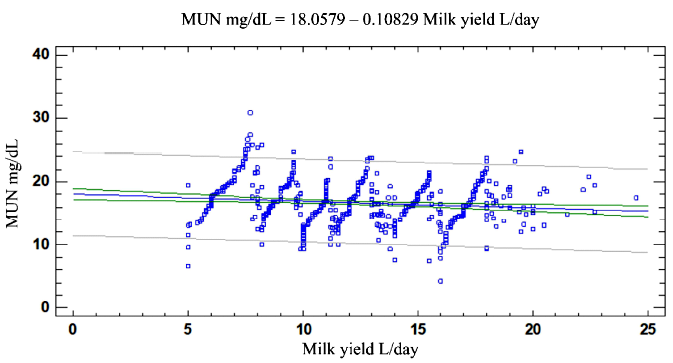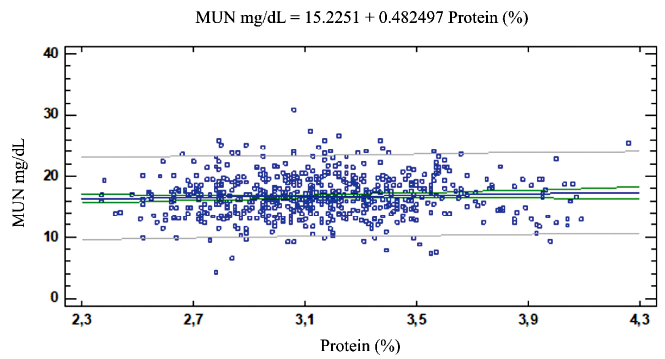INTRODUCTION
Urea is a product of protein metabolic processes. In ruminants, its main source is the ammonium formed in the rumen, which is transformed into urea in the liver and protein body catabolism (Mucha & Stangberg, 2011; Jin et al., 2018; Tarazona-Manrique et al., 2021). Blood urea nitrogen (BUN) can cross the epithelial barriers of the mammary gland and exit through milk. The metabolite found in milk is called milk urea nitrogen (MUN) and its concentration is related to BUN (Ruska & Junkens, 2014).
MUN is strongly linked with external factors such as the climatic season, as well as aspects of feeding such as the percentage of protein, the energy/protein ratio and its digestibility, and factors related to the animal such as the ruminal microbiome, number of calvings, days in milk (DIM) and production level, among others (Doskaet al., 2012; Conti et al., 2014; Kananub et al., 2018; Tarazona-Manrique et al., 2021).
The monitoring of MUN concentration in milk has comparative advantages to serum samples because milk sampling is atraumatic for the animal, avoiding stressful situations that can affect its productive regimen and cause accidents both for the veterinarian and for the animal (Sánchez, 2016). In addition, this monitoring allows the identification of the relationship of its concentration with possible reproductive alterations, an increase in somatic cell counts, and even a negative environmental impact through an increased nitrogen excretion (Doska et al., 2012; El Shewy et al., 2010; Kgole et al., 2012; Spek et al., 2012).
Some studies in Colombia aimed at determining increasing levels of non-protein nitrogen and its influence on nitrogenous metabolites, including MUN (Galvis et al., 2011), fluctuations in MUN together with lactose during lactation (Henao et al., 2014), and the effect of DIM and seasons on variation of MUN in dairy cows of the Boyacá highlands (Tarazona-Manrique et al., 2021); however, no studies have been found determining if the concentration of MUN varies concerning milk production and protein concentration in milk in the productive context of Boyacá. Therefore, the aim of this study was to determine the variation and correlation between MUN content according to milk yield and total protein in milk of Holstein cows in the department of Boyacá, Colombia.
MATERIALS AND METHODS
Type of Study
A retrospective study was conducted using data obtained in a previous study between January 2018 and December 2019 in the municipality of Duitama-Boyacá. There, second and third parity Holstein cows from two farms (n=112) were selected. Cows were in healthy conditions, without respiratory, reproductive, and udder diseases (somatic cell count<200 000 cells/m). Feeding conditions, sampling, and processing can be found in Tarazona-Manrique et al. (2021).
Data Analysis
Data from 4901 milk samples, including MUN concentration (mg/dl), somatic cell count (cells/ml), milk yield (l/day), and physicochemical analysis of milk (percentage of fat, protein, and lactose) were stored in an MS Excel(r) sheet. For this study, only the MUN, milk yield, and milk protein percent data were considered for the statistical analysis.
Samples were analysed at the Laboratory of Milk Quality Analysis and Mastitis Control at the Universidad Pedagógica y Tecnológica de Colombia. MUN analysis was performed using the enzymatic spectrophotometric methodology using a Mindray BS120 kit using the Urea kit from LAB TEST at a wavelength of 450 nm. The physicochemical analysis of milk was performed at the same lab, using the Milkoscan Mars(r) (FOSS). In addition, somatic cell counting was performed with a Fossomatic(tm) 7-based flow cytometry.
The data was grouped according to levels of milk yield as Group 1 (<10 l/day), Group 2 (≥10 and <15 l/day), and Group 3 (≥15 l/day) and according to protein percent as Group 1 (>2.3 and <3.0%), Group 2 (≥3.0 and <3.5%) and Group 3 (≥3.51 and <4.3%), without considering the year of sampling or farm. Univariate analysis of variance was performed using the comparison of the means Fisher's least significant difference (LSD) procedure, with a confidence level of 95% (p<0.05). The Statgraphics Centurion(r) software for Windows 10 was used. The independent variables were milk yield and protein percent and the dependent variables for both cases were the MUN concentration. In addition, a simple linear correlation analysis was performed between each variable, positioning the MUN variable on the "y" axis, and protein percent and daily milk yield on the "x" axis.
RESULTS
MUN concentration according to levels of milk yield significantly varied between groups, but not between and milk protein groups (Table 1).
Table 1 Average milk urea nitrogen (MUN, mg/dl) according to milk yield (l/day) and milk protein content (%) in Holstein cows (Boyacá, Colombia)

a,b,c Different superscripts indicate significative differences (p<0.05)
1 Group 1: <10 l/d, Group 2: ≥10-<15 l/d; Group 3: ≥15 l/d
2 Group 1: >2.3-<3.0%, Group 2: ≥3.0-<3.5%, Group 3: ≥3.5-<4.3%
SD: Standard deviation of the mean
The results of the simple linear correlation analysis for each variable are displayed in figures 1 and 2. The correlation coefficient between the variables MUN and milk yield per day showed a weak and negative correlation (-0.125; p<0.05). However, the correlation coefficient between MUN and milk protein percent (0.048) was not statistically significant.

Figure 1 Simple correlation analysis for variables milk urea nitrogen (MUN, mg/dl) and daily milk yield in Holstein cows in Boyacá, Colombia
DISCUSSION
This is the first study in the context of the Boyacá highlands evaluating the variation of MUN in relation to milk yield and milk protein. In this study, significant differences were found between levels of milk yield and MUN concentration, where MUN concentration is reduced with the increase in milk yield; however, the correlation analysis failed to prove this relationship. On the other hand, Henao et al. (2014) in Antioquia, Colombia determined that milk yield was not related to MUN concentration. The reasons for these changes in MUN concentrations were unclear. Feeding was not probably an issue if considering the feeding quality and management were quite similar and the two farms were not more than 3 km apart.
Montoya-Zuluaga et al. (2017) working in Antioquia found that as milk protein content increased the concentration of MUN decrease; however, in the present study there were no statistical differences between MUN concentration due to protein content and the correlation coefficient was also not significant. These differences might be related to the type of feeding, although these authors did not indicate the type of diet used.
Regarding the concentrations of MUN and milk protein in milk, several research groups (Godden et al., 2001; Arunvipas et al., 2003; Stoop et al., 2007; Hossein & Ardalan, 2011; Mucha & Strandberg, 2011; Doska et al., 2012) determined a weak and positive correlation between the two variables, but without statistical power. On the other hand, in regards to the correlation between MUN and milk yield, various studies show a positive correlation (Godden et al., 2001; Meyer et al., 2006; Hossein &Ardalan, 2011; Doska et al., 2012; Nozad et al., 2012; Roveglia et al., 2019) associating these results to protein-rich diets in high-producing cows (Sousa et al., 2006), while other studies found no relationship between these two parameters (Gustafsson & Carlsson, 1993; Eicher et al., 1999), and even negative association (Trevaskis & Fulkerson, 1999; Stoop et al., 2007), as revealed in this study.
CONCLUSIONS
Milk urea nitrogen (MUN) concentration is reduced with the increase in milk yield, but without differences due to levels of milk protein in Holstein cows of the Boyacá highlands.
Weak and negative correlation was found between milk yield and MUN concentration, but a non-significant correlation between milk protein percentage and MUN concentration.












 uBio
uBio 



